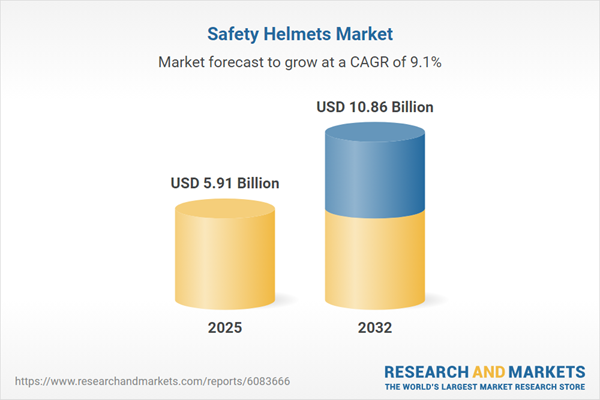Speak directly to the analyst to clarify any post sales queries you may have.
The global safety helmets market is experiencing a rapid transformation, blending material innovation, digital technology, and evolving industry requirements. As organizations prioritize worker safety and regulatory compliance, safety helmet solutions are being redefined to address operational challenges and emerging risks across sectors.
Market Snapshot: Safety Helmets Market Size and Growth
The Safety Helmets Market grew from USD 5.43 billion in 2024 to USD 5.91 billion in 2025. It is projected to continue expanding at a compound annual growth rate (CAGR) of 9.05%, reaching USD 10.86 billion by 2032. This growth is fueled by advanced materials, stricter regulations, technological integration, and increasing end-user awareness.
Scope & Segmentation
- Types: Industrial helmets and sports helmets, covering applications in automotive maintenance, construction, mining, bicycle, equestrian, and motorcycle activities.
- Material Types: Composite, fiberglass, polycarbonate, and polyethylene—each offering a unique balance of durability, performance, and cost.
- End Users: Construction, manufacturing, oil & gas, transportation, and utilities represent primary industry segments, each with specific safety, comfort, and regulatory needs.
- Distribution Channels: Both offline and online methods, with options including distributors, retailers, specialty stores, and digital direct-to-consumer channels.
- Geographies: Detailed coverage includes the Americas (North America, Latin America), Europe, Middle East, Africa, and Asia-Pacific, reflecting regional strategies and local standards.
- Key Companies: Leading vendors include Honeywell International Inc., 3M Company, MSA Safety Incorporated, JSP Co., Ltd, UVEX SAFETY GROUP GmbH & Co. KG, Bullard, Bollé Brands SAS, KASK S.r.l., Centurion Safety Products Ltd, and Protective Industrial Products, Inc.
Key Takeaways: Strategic Insights for Senior Leaders
- Innovative materials such as high-performance composites and bio-based alternatives are shifting helmet design towards lighter, stronger, and more sustainable models.
- Regulatory bodies globally are pushing for advanced safety features, including multi-impact resistance, flame retardancy, and increased visibility requirements.
- Digital transformation is introducing smart helmet solutions equipped with IoT-enabled sensors for real-time impact monitoring, environmental analysis, and biometric data capture.
- Regional differences dictate unique compliance and product adaptation strategies; North America and Europe emphasize certification rigor, while Asia-Pacific focuses on scaling production and local demand alignment.
- Distribution expansion through both traditional and digital channels is enabling seamless product customization and agile fulfillment for diverse industries.
- Manufacturers are investing in after-sales service, field testing, and training programs to maximize user adoption and safety outcomes.
Tariff Impact on Supply Chains and Costs
Additional tariffs imposed by the United States in 2025 have restructured supply chain strategies and cost models for helmet components. Manufacturers are revising sourcing, exploring domestic production, and deepening regional partnerships to reduce exposure and maintain pricing competitiveness. Efforts include accelerated vertical integration, alternative material sourcing, automated molding investments, and just-in-time inventory management. These proactive measures are aimed at tempering cost volatility and ensuring operational resilience.
Methodology & Data Sources
Our analysis uses both secondary and primary research, combining published technical literature with interviews from leading manufacturers, suppliers, and distribution partners. Data is validated through field visits, end-user surveys, and review of transaction records to ensure documented, actionable findings.
Why This Report Matters
- Enables informed decisions by benchmarking technology shifts, regional opportunities, and leading vendor strategies in the safety helmets market.
- Supports procurement, product development, and compliance teams with current insights on regulatory trends and supply chain dynamics affecting operational efficiency.
- Empowers executives and category managers to anticipate market changes, implement risk-mitigation strategies, and identify high-growth segments.
Conclusion
The safety helmets market is advancing through a convergence of material upgrades, digital enhancements, and regulatory influence. Senior leaders can leverage these insights to position their organizations for growth, resilience, and sustained industry leadership.
Table of Contents
3. Executive Summary
4. Market Overview
7. Cumulative Impact of Artificial Intelligence 2025
List of Figures
Samples

LOADING...
Companies Mentioned
The key companies profiled in this Safety Helmets market report include:- Honeywell International Inc.
- 3M Company
- MSA Safety Incorporated
- JSP Co., Ltd
- UVEX SAFETY GROUP GmbH & Co. KG
- Bullard
- Bollé Brands SAS
- KASK S.r.l.
- Centurion Safety Products Ltd
- Protective Industrial Products, Inc.
Table Information
| Report Attribute | Details |
|---|---|
| No. of Pages | 194 |
| Published | October 2025 |
| Forecast Period | 2025 - 2032 |
| Estimated Market Value ( USD | $ 5.91 Billion |
| Forecasted Market Value ( USD | $ 10.86 Billion |
| Compound Annual Growth Rate | 9.0% |
| Regions Covered | Global |
| No. of Companies Mentioned | 11 |









